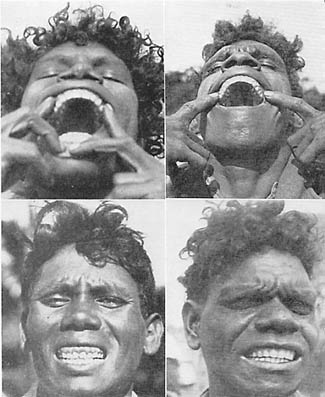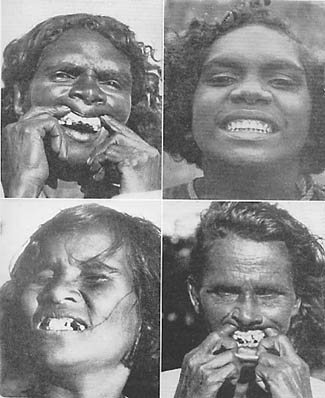If you missed the first three posts in this series, you can find them here:
1st principle of a nourishing traditional diet: Sacred foods
2nd principle of a nourishing traditional diet: Nutrient density
3rd principle of a nourishing traditional diet: Animal products
Before I reveal the fourth principle of a nourishing traditional diet, I wanted to show you some photos that Dr Price took on his trip to Australia, where he compared the teeth and dental arches of Aborigines still eating their traditional diet with those who had adopted modern industrial foods into their diets.
 |
| FIG. 53 from Nutrition and Physical Degeneration: "No other primitive race seems to deserve so much credit for skill in obeying nature's laws as these primitive Aborigines because of the perpetual drought hazards of much of the land they live in. Half of Australia has less than ten inches of rain per year. Note the magnificent dental arches and beautiful teeth of these primitives. Tooth decay was almost unknown in many districts." |
 |
| FIG. 54 from Nutrition and Physical Degeneration: "Wherever the primitive Aborigines have been placed in reservations and fed on the white man's foods of commerce dental caries has become rampant. This destroys their beauty, prevents mastication, and provides infection for seriously injuring their bodies. Note the contrast between the primitive woman in the upper right and the three modernized women." |
All traditional cultures ate most foods cooked, but some animal foods raw
Traditional cultures usually cooked their plant foods to neutralise the many toxins that can be found in plants.
However, healthy traditional cultures always consumed some animal foods raw, for example:
- Raw milk, butter, cream and cheese
- Raw and marinated fish
- Raw shellfish
- Steak tartare, carpaccia
An important nutrient found in raw meat and dairy is vitamin B6, which is destroyed by heat. Without regular consumption of raw animal products it is easy to become deficient in vitamin B6, and deficiency is linked to:
- Diabetes
- Heart disease
- Nervous disorders
- Cancer
- Kidney failure
- Asthma
- PMS
- Morning sickness
- Toxemia in pregnancy
- Alcoholism
So there are lots of good reasons to get some raw meat or dairy into your diet. Off the top of my head, the only raw animal foods I think I consume at present are milk, cream and salmon (on sushi). I hope that's enough to keep my Vitamin B6 levels up.
What raw animal foods do you eat, or could you imagine eating if you were to start?

I was happy to see milk on the list, as I'm not too keen on raw red meat, and its hard to get fresh fish here, being 200km from the coast (otherwise I happily eat sashimi). We are drying up Bella the house cow this week, so I've been freezing lots of milk, not going to be happy when that runs out :( although there is a local supplier of "cosmetic" raw milk that we may have to use instead. This is probably the most difficult principle for most people to achieve (without a house cow).
ReplyDeleteI guess all the cheese you've made would count as raw dairy too, so that will help keep you in raw goodness while Bella is dried off. Are you going to get her in calf again?
DeleteMilk all the way!
ReplyDelete